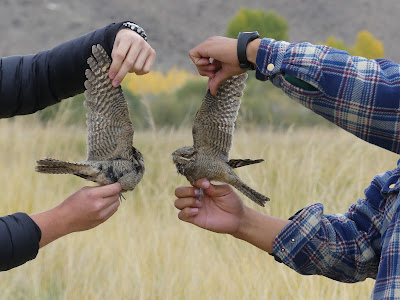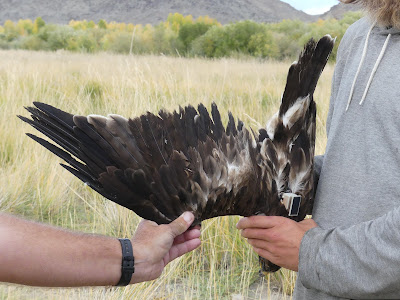Livestock also features heavily in the traditions of Mongolia, as it does at this site. There is a herd of 100+ cows. They created continuous problems, having nets down over night and walking through nets during the day. Added to this the nets were all across the river, by the time we joined the camp and to access these via the better bridge, adds a full 20 minutes to each round, and nets were located both north and south along the river. Rounds regularly to up to an hour.
Our team consisted of four qualified ringers from UK, Denmark, & Sweden, a trainee from France
(two individuals that switched to do a week each) and Mongolian ringer and two Mongolian students.
We were expecting temperatures to drop during our stay, but there was an unexpected heatwave that saw temperatures up to 28C during the afternoon. This was probably a factor in stalling migration and may explain, to some extent, the low daily totals. Whenever possible the nets were open all day.
If you are thinking of travelling to support the Khovd ringing camp, do by all means feel free to contact us on clamsdell@gmail.com or deniselamsdell@rocketmail.com.
Now, on to the birds. This post includes totals of the two weeks with general and bird images. There will be supplementary posts for birds of particular interest.
Cuckoo ringed 14/09, a rather late individual so potentially Oriental,
but no consistent points in the hand so feather samples were taken.
Hume's Leaf Warbler
Little Bunting
Little Bunting, Godlewski's Bunting & Meadow Bunting
Yellow-browed Bunting
Olive-backed Pipit
Evermann's Redstart male
Evermann's/ Eastern Black Redstart mantle comparison
Eastern Black Redstart
White-crowned Penduline Tit juvenile
Black-throated Accentor
On the 17th we caught two Nightjars in the first round. The larger bird was European, but the second, smaller bird did not match anything that any of us knew of, other than perhaps Little Indian Nightjar that seemed incorrect with regard to the markings.
European Nightjar (P2=4/5)
Smaller Nightjar species (P2=3/4)
Full wing formula was recorded for both.
Yellow-browed Warbler
Japanese Sparrowhawk
Lesser Whitethroat, believed Magellenica - feather samples
are taken from all Lesser Whitethroats. The project is working to determine
which sub-species pass through the region.
3rd year Booted Eagle fitted with satellite tracker.
Blyth's Reed Warbler
White's Thrush
Pallas's Leaf Warbler
Wood Warbler
Paddyfield Warbler
Azure Tit
Oriental Scops Owl
Black-throated Thrush female
Hume's Leaf Warbler
Hume's Leaf Warbler - adult (L) and juvenile (R)
Dusky Warbler
Pallas's Leaf Warbler, Hume's Leaf Warbler, Yellow-browed Warbler
Brown Accentor
Brambling
The standard data collected for each bird is species, age,wing length, P8 (or 3 depending on which numbering system you're using - third from outer most primary), tail length, bill length, tarsus length, net number, time, date, ringer with feather samples taken for several species where precise details of sub-species present is under investigation.
14/9
|
15/9
|
16/9
|
17/9
|
18/9
|
19/9
|
20/9
|
|
Booted Eagle
|
1
|
||||||
Japanese Sparrowhawk
|
1
|
||||||
Oriental Scops Owl
|
1
|
||||||
Common Cuckoo
|
1
|
||||||
European Nightjar
|
1
|
||||||
Small Nightjar sp
|
1
|
||||||
Tree Pipit
|
1
|
||||||
Olive-backed Pipit
|
1
|
1
|
1
|
||||
Black-throated Accentor
|
1
|
1
|
4
|
2
|
|||
Brown Accentor
|
1
|
||||||
Bluethroat
|
5
|
1
|
1
|
3
|
2
|
||
Red-flanked Bluetail
|
4
|
2
|
3
|
2
|
2
|
||
Black Redstart (Eastern)
|
3
|
3
|
2
|
2
|
3
|
3
|
|
Eversmann’s Redstart
|
1
|
1
|
1
|
3
|
1
|
||
Black-throated Thrush
|
5
|
3
|
5
|
5
|
3
|
4
|
1
|
Black/Red-throated hybrid
|
2
|
2
|
|
2
|
|
1
|
|
White’s Thrush
|
|
|
|
|
1
|
|
|
Grasshopper Warbler
|
1
|
||||||
Paddyfield Warbler
|
1
|
1
|
|||||
Blyth’s Reed Warbler
|
1
|
1
|
2
|
||||
Lesser Whitethroat
|
18
|
5
|
2
|
4
|
5
|
2
|
2
|
Wood Warbler
|
1
|
1
|
|||||
Yellow-browed Warbler
|
1
|
1
|
1
|
2
|
3
|
1
|
2
|
Hume’s Warbler
|
312
|
58
|
80
|
49
|
63
|
17
|
30
|
Pallas’s Warbler
|
1
|
1
|
|||||
Dusky Warbler
|
1
|
1
|
1
|
1
|
4
|
1
|
|
Chiffchaff (Siberian)
|
33
|
12
|
15
|
13
|
13
|
5
|
6
|
Greenish Warbler
|
1
|
||||||
Arctic Warbler
|
1
|
||||||
Spotted Flycatcher
|
2
|
1
|
1
|
1
|
|||
Azure Tit
|
5
|
1
|
|||||
White-crowned Penduline Tit
|
2
|
11
|
1
|
2
|
|||
Isabelline Shrike (Daurian)
|
1
|
||||||
Tree Sparrow
|
1
|
||||||
Chaffinch
|
4
|
1
|
|||||
Brambling
|
1
|
4
|
4
|
2
|
1
|
1
|
|
Common Rosefinch
|
6
|
4
|
1
|
5
|
1
|
||
Godlewski’s Bunting
|
1
|
1
|
1
|
||||
Meadow Bunting
|
2
|
1
|
2
|
||||
Ortolan Bunting
|
1
|
2
|
|||||
Pallas’s Reed Bunting
|
1
|
||||||
Little Bunting
|
1
|
5
|
1
|
1
|
1
|
||
Yellow-browed Bunting
|
1
|
||||||
Total:
|
406
|
92
|
143
|
94
|
120
|
49
|
60
|
Common Rosefinch
Pallas's Grasshopper Warbler
Goldcrest
A second small Nightjar captured after dusk, bringing the total
of these small birds to three this autumn.
Willow Warbler (note greyish cast)
Mugimaki Flycatcher
Koslov's Accentor (fresh plumage)
2nd Koslov's Accentor (very worn plumage presumed adult)
Taiga Flycatcher
Red-throated Thrush
We did not expect the number of hybridized birds that we saw in Black-throated and Red-throated Thrushes. The criteria noted in the Handbook of Western Palearctic Birds was used and it was noted that remarks concerning numbers of hybrid individuals seemed inconsistent with the birds being processed.
21/9
|
22/9
|
23/9
|
24/9
|
25/9
|
26/9
|
27/9
|
|
Eurasian Sparrowhawk
|
1
|
1
|
1
|
||||
Black Stork
|
1
|
||||||
Laughing Dove
|
1
|
||||||
European Nightjar
|
2
|
1
|
|||||
Small Nightjar sp
|
1
|
||||||
Tree Pipit
|
1
|
||||||
Olive-backed Pipit
|
1
|
||||||
Black-throated Accentor
|
2
|
2
|
|||||
Brown Accentor
|
1
|
||||||
Kozlov's Accentor
|
1
|
1
|
1
|
||||
Bluethroat
|
1
|
2
|
3
|
2
|
7
|
||
Red-flanked Bluetail
|
1
|
1
|
1
|
2
|
|||
Black Redstart (Eastern)
|
2
|
4
|
1
|
1
|
4
|
2
|
7
|
Eversmann’s Redstart
|
6
|
8
|
1
|
5
|
8
|
12
|
20
|
Eye-browed Thrush
|
1
|
||||||
Black-throated Thrush
|
5
|
3
|
1
|
1
|
2
|
||
Red-throated Thrush
|
1
|
1
|
|||||
Black/Red-throated hybrid
|
10
|
1
|
2
|
3
|
2
|
4
|
|
Pallas’s Grasshopper Warbler
|
1
|
||||||
Paddyfield Warbler
|
2
|
||||||
Blyth’s Reed Warbler
|
2
|
1
|
1
|
||||
Lesser Whitethroat
|
1
|
1
|
4
|
1
|
2
|
1
|
|
Wood Warbler
|
1
|
||||||
Willow Warbler
|
1
|
1
|
|||||
Yellow-browed Warbler
|
2
|
1
|
1
|
1
|
|||
Hume’s Warbler
|
16
|
10
|
5
|
4
|
6
|
18
|
20
|
Pallas’s Warbler
|
1
|
||||||
Dusky Warbler
|
1
|
||||||
Chiffchaff (Siberian)
|
23
|
13
|
3
|
21
|
40
|
30
|
46
|
Greenish Warbler
|
1
|
||||||
Goldcrest
|
1
|
3
|
|||||
Spotted Flycatcher
|
1
|
1
|
|||||
Taiga Flycatcher
|
1
|
1
|
1
|
1
|
|||
Mugimaki Flycatcher
|
1
|
||||||
Great Tit
|
1
|
||||||
Azure Tit
|
4
|
2
|
1
|
2
|
3
|
1
|
2
|
White-crowned Penduline Tit
|
3
|
||||||
Isabelline Shrike (Daurian)
|
1
|
||||||
Magpie
|
1
|
||||||
Tree Sparrow
|
1
|
1
|
|||||
Chaffinch
|
2
|
3
|
3
|
2
|
4
|
8
|
|
Brambling
|
3
|
5
|
1
|
2
|
|||
Greenfinch
|
3
|
||||||
Common Rosefinch
|
1
|
1
|
3
|
1
|
2
|
||
Meadow Bunting
|
5
|
2
|
22
|
3
|
10
|
||
Reed Bunting
|
1
|
||||||
Pine Bunting
|
1
|
1
|
|||||
Little Bunting
|
1
|
2
|
2
|
2
|
1
|
||
Total:
|
71
|
74
|
35
|
51
|
110
|
87
|
143
|
Siberian Chiffchaff
Laughing Dove
Pine Bunting
European Sparrowhawk
Juvenile Black Stork
Eye-browed Thrush
Isabelline Shrike
The house at Khovd ringing camp
Washing up is an outdoor activity
Collecting drinking water
View from the house door
A typical meal
The better bridge
Most rides were in the sallows by the river
All cooked meals included a little of the goat that had been
bought and slaughtered the week before we arrived.
Chris scribes for students Nansa and Tourno
Dumplings are a Mongolian favorite
Kitchen and ringing room
Meal times around the low table are quite cosy
as half the room is used for a sleeping area
Cows are a constant factor, whether it's in the rubbish or the net rides











































































